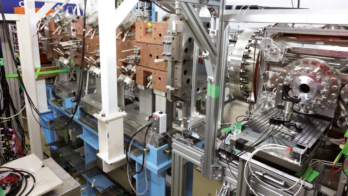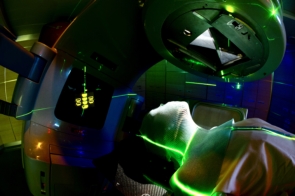The upcoming Facility for Rare Isotope Beams (FRIB) in Michigan underpins an ambitious programme to transform nuclear physics and its applications. Joe McEntee reports.

The $730 million Facility for Rare Isotope Beams (FRIB) at Michigan State University (MSU) is scheduled to come online in early 2022 – a game-changer in every sense for the US and international nuclear-physics communities. With peer review and approval of the first round of experimental proposals now complete, an initial cohort of scientists from 25 countries is making final preparations to exploit FRIB’s unique capabilities. Their goal: to open up new frontiers in the fundamental study of rare and unstable isotopes as well as identifying promising candidate isotopes for real-world applications.
The engine-room of the FRIB scientific programme is an all-new 400 kW superconducting radiofrequency (SRF) linac. In short: the world’s most powerful heavy-ion driver accelerator, firing beams of stable isotopes at targets of heavier nuclei (for example, carbon or beryllium). Amid the chaos of flying particles, two nuclei will occasionally collide, fusing to form a rare and unstable isotope – a process that ultimately delivers high-intensity beams of rare isotopes to FRIB’s experimental end-stations and a suite of scientific instruments.
Funded by the US Department of Energy Office of Science (DOE-SC), and supported by MSU cost-share and contributions, FRIB will operate as a traditional big-science user facility, with beam-time granted via merit review of proposals and access open to all interested researchers. Here, FRIB’s scientific director, Bradley Sherrill, tells CERN Courier how the laboratory is gearing up for “go-live” and the importance of wide-ranging engagement with the international user community, industry and other rare-isotope facilities.
What are the overarching objectives of the FRIB scientific mission?

There are four main strands to the FRIB science programme. For starters, user experiments will generate a wealth of data to advance our understanding of the nucleus – how it’s put together and how we can develop theoretical nuclear models and their approximations. At the same time, the research programme will yield unique insights on the origins of the chemical elements in the universe, providing access to most of the rare isotopes involved in extreme astrophysical processes such as supernovae and neutron-star mergers. Other scientists, meanwhile, will use isotopes produced at FRIB to devise experiments that look beyond the Standard Model, searching for subtle indications of hidden interactions and minutely broken symmetries. Finally, FRIB will generate research quantities of rare isotopes to feed into R&D efforts on next-generation applications – from functional medical imaging to safer nuclear reactors and advanced detector technologies.
What is FRIB’s biggest differentiator?
The 400 kW SRF linac is the heart of FRIB’s value proposition to the research community, opening up access to a much broader spectrum of rare isotopes than hitherto possible – in fact, approximately 80% of the isotopes predicted to exist. It is worth noting, though, that FRIB does not exist in isolation. It’s part of a global research ecosystem, with a network of collaborations ongoing with other rare-isotope facilities – among them RIKEN’s RI Beam Factory in Japan, RAON in Korea, ISOLDE at CERN, FAIR in Germany, GANIL in France and ISAC at TRIUMF in Canada. Collectively, FRIB and this global network of laboratories are well placed to deliver unprecedented – and complementary – advances across the nuclear-science landscape over the coming decades.
Is it realistic to expect broader commercial opportunities to emerge from FRIB’s research programme?
There’s a high likelihood of FRIB yielding spin-off technologies and commercial applications down the line. One of the game-changers with FRIB is the quantities of rare isotopes the beamline can produce with high efficiency – a production scheme that enables us to make a broad swathe of isotopes relatively quickly and with high purity. That capability, in turn, will enable potential early-adopters in industry to fast-track the evaluation of novel applications and, where appropriate, to figure out how to produce the isotopes of interest at scale (see “FRIB’s bumper harvest will fuel applied science and innovation”).
How is FRIB engaging with the scientific user community across academia, industry and government agencies?
FRIB enjoys strong links with its future users – both here in the US and internationally – and meets with them regularly at planning events to identify and coordinate research opportunities. Earlier this year, in response to our first call for proposals, we received 82 project submissions and six letters of intent from 130 institutions across 30 countries. Those science proposals were subsequently peer-reviewed by the FRIB Programme Advisory Committee (PAC), an international group of nuclear science experts which I convene, to yield an initial set of experiments that will get underway once FRIB commences user operations in early 2022.
Those PAC-recommended experiments align with national science priorities across the four FRIB priority areas: properties of rare isotopes; nuclear astrophysics; fundamental interactions; and applications for society. The headline numbers saw 34 (out of 82 requested) experiments approved with a projected 4122 facility-use hours. There are 88 institutions, 24 US states and 25 countries represented in the initial experimental programme.
FRIB’s bumper harvest will fuel applied science and innovation
An excess of useful radioisotopes will be formed as FRIB fulfils its basic science mission of providing rare-isotope beams to feed a broad-scope international user programme. For the FRIB beams to reach high purity, though, the vast majority of these “surplus” isotopes will end up discarded in a water-filled beam dump – stranded assets that go unused and remain largely unexplored.
With this in mind, the DOE-SC Office of Nuclear Physics, through the DOE Isotope Programme, has awarded FRIB scientists $13 million in funding over the next four years to build up FRIB’s isotope harvesting capabilities. The hope is that systematic recovery of the surplus isotopes – without impacting FRIB’s primary users – could open up novel lines of enquiry in applied research – from biochemistry to nuclear medicine, and from radiothermal generators to nuclear-weapons stockpile stewardship.
“This grant is about broadening the scientific impact of FRIB,” says Greg Severin, lead investigator for the harvesting project at FRIB. “While physicists at FRIB are making ground-breaking fundamental discoveries, our team will be supporting exciting opportunities in applied science.”
In 2018, the DOE-SC awarded Severin and colleagues an initial grant to prove that isotope harvesting is feasible. Their proof-of-concept involved building a small-scale isotope harvester in FRIB’s predecessor, the National Superconducting Cyclotron Laboratory at MSU.
Now, with follow-on funding secured, Severin’s team is scaling up, with construction of a dedicated Isotope Harvesting Vault at FRIB in the works and set for completion in 2024.
See also “Isotope harvesting at FRIB: additional opportunities for scientific discovery” (J. Phys. G: Nucl. Part. Phys. 2019 46 100501).
What are the opportunities for early-career scientists and engineers at FRIB?
Developing the talent pipeline is part of the organisational DNA here at FRIB. There’s a structured educational framework to pass on the expertise and experience of senior FRIB staff to the next generation of researchers, engineers and technicians in nuclear science. MSU’s Accelerator Science and Engineering Traineeship (ASET) programme is a case in point. ASET leverages multidisciplinary expertise from FRIB and MSU colleagues to support specialisation in four key areas: physics and engineering of large accelerators; SRF technology; radiofrequency power engineering; and large-scale cryogenic systems.
There’s a high likelihood of FRIB yielding new spin-off technologies as well as commercial applications
Many MSU ASET students supplement their courses through participation in the US Particle Accelerator School, a national programme that provides graduate-level training and workforce development in the science of particle beams and associated accelerator technologies. At a more specialist level, there’s also the MSU Cryogenic Initiative, a unique educational collaboration between the university’s college of engineering and FRIB’s cryogenics team. Meanwhile, we continue to prioritise development of a more diverse workforce, partnering with several academic institutions that traditionally serve under-represented groups to broaden participation in the FRIB programme.
In what ways does FRIB ensure a best-practice approach to facilities management?
Sustainability and continuous improvement underpin all FRIB working practices. We are an ISO14001-registered organisation, which means we measure ourselves against an international standard specifying requirements for effective environmental management. That’s reflected, for example, in our use of energy-efficient superconducting technologies, and also our efforts to minimise any helium wastage through an exhaustive capture, recovery and reuse scheme within FRIB’s cryogenic plant.
We also have an ISO 9001-registered quality management system that guides how we address scientific user needs; an ISO 45001-registered occupational health and safety management system to keep our workers safe; and an ISO 27001-registered information security management system.
How important is FRIB’s relationship with industry?
Our strategic partnerships with industry are also significant in driving organisational efficiencies. The use of standard industry components wherever possible reduces maintenance and training requirements, minimises the need for expensive product inventory, and lowers our operational costs. We engage with manufacturers on a co-development basis, fast-tracking innovation and knowledge transfer so that they are able to produce core enabling technologies for FRIB at scale – whether that’s accelerator cavities, superconducting magnets, or vacuum and cryogenic subsystems.





